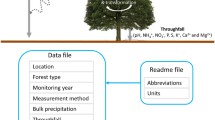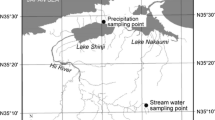Abstract
Being downwind of eastern and midwestern industrial centers, the Hubbard Brook Experimental Forest offers a prime location to monitor long-term trends in atmospheric chemistry. Continuous measurements of precipitation chemistry during the last 10 yr provide a measure of recent changes in precipitation inputs of H ion. The weighted average pH of precipitation during 1964–65 to 1973–74 was 4.14, with a minimum annual value of 4.03 in 1970–71 and a maximum annual value of 4.21 in 1973–74. The sum of all cations except H ion decreased from 51 μeq 1−1 in 1964–65 to 23 μeq 1−1 in 1973–74 providing a significant drop in neutralizing capacity during this period. Based upon regression analysis, the input in equivalents of H ion and nitrate increased by 1.4-fold and 2.3-fold respectively, from 1964–65 to 1973–74. Input of all other ions either decreased or showed no trend. Based upon a stoichiometric formation process in which a sea-salt, anionic component is subtracted from the total anions in precipitation, SO4 =, contribution to acidity dropped from 83% to 66%, whereas NO3 − increased from 15% to 30% during 1964–65 to 1973–74. The increased annual input of H ion at Hubbard Brook during the past 10 yr is highly correlated with the increased input of nitrate in precipitation.
Similar content being viewed by others
References
Barrett, E. and Brodin, G.: 1955, Tellus, 7, 251.
Cogbill, C. V.: 1975, Acid precipitation and forest growth in the northeastern United States. M.S. Thesis, Cornell University, Ithaca, New York.
Cogbill, C. V. and Likens, G. E.: 1974, Water Resour. Res. 10(6), 1133.
Johnson, N. M., Reynolds, R. C., and Likens, G. E.: 1972, Science 177(4048), 514.
Junge, C. E.: 1958, Trans. Am. Geophys. Union 39, 241.
Junge, C. E. and Werby, R. T.: 1958, J. Meteorol. 15, 417.
Likens, G. E.: 1972, The chemistry of precipitation in the central Finger Lakes region. Cornell University Water Resour. Mar. Sci. Center, Ithaca, New York. Tech. Rept. 50, 62 pp.
Likens, G. E. and Bormann, F. H.: 1974, Science 184(4142), 1176.
Likens, G. E. and Bormann, F. H.: 1975, Science 188, 957.
Likens, G. E., Bormann, F. H., and Johnson, N. M.: 1972, Environment 14(2), 33.
Likens, G. E., Bormann, F. H., Pierce, R. S., Eaton, J. S., and Johnson, N. M.: 1977, The Biogeochemistry of a Northern Hardwood Forest Ecosystem, Springer-Verlag New York Inc. (In Press).
Whittaker, R. H., Bormann, F. H. Likens, G. E., and Siccama, T. G.: 1974, Ecol. Monogr. 44(2), 233.
U.S. Environmental Protection Agency: 1973, Monitoring and Air Quality Trends Report. National Air Monitoring Program, 450/1-74-007. 338 pp.
Author information
Authors and Affiliations
Rights and permissions
About this article
Cite this article
Likens, G.E., Bormann, F.H., Eaton, J.S. et al. Hydrogen ion input to the hubbard brook experimental forest, New Hampshire, during the last decade. Water, Air, and Soil Pollution 6, 435–445 (1976). https://doi.org/10.1007/BF00182884
Received:
Issue Date:
DOI: https://doi.org/10.1007/BF00182884




